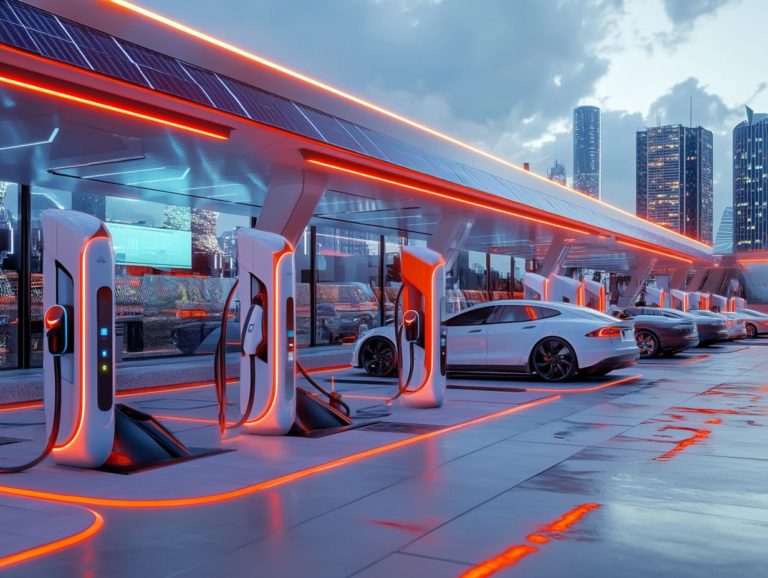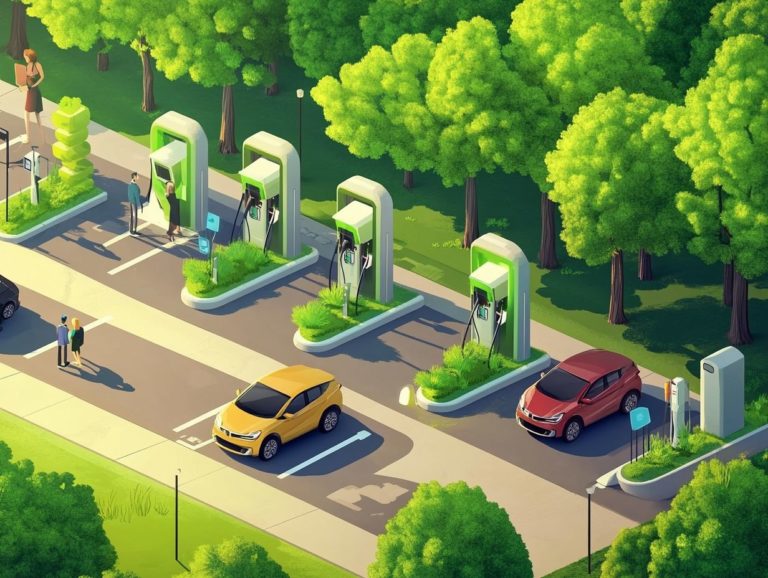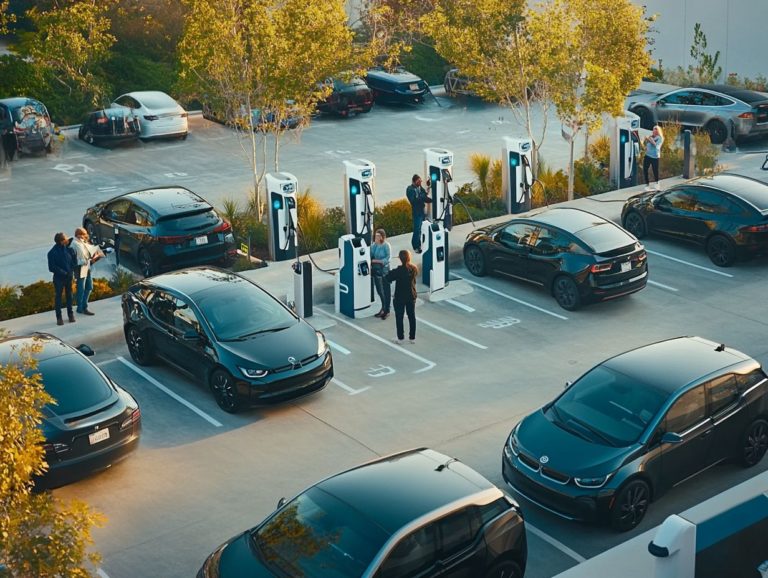How to Plan Charging for Your Electric Fleet
As businesses worldwide increasingly prioritize sustainability, transitioning to an electric fleet is a game-changer for your operations. This shift offers significant environmental benefits and substantial cost savings.
Embracing this change requires meticulous planning, especially regarding charging infrastructure. This guide explores essential factors to consider, from optimal location and robust infrastructure to creating an effective charging plan.
You’ll find practical tips for a seamless transition and insights on efficiently managing your fleet’s charging needs. Uncover how to maximize the potential of your electric fleet and drive your business forward sustainably.
Contents
- Key Takeaways:
- Understanding the Benefits of an Electric Fleet
- Factors to Consider When Planning Charging for Your Electric Fleet
- Creating a Charging Plan
- Implementing and Managing Charging for Your Electric Fleet
- Essential Tips for a Smooth Transition to Your Electric Fleet!
- Frequently Asked Questions
- What is an electric fleet?
- Why should you plan charging for an electric fleet?
- What factors should I consider when planning charging for my electric fleet?
- How do I determine the charging needs of my electric fleet?
- What are the different types of charging options for an electric fleet?
- How can I make charging more convenient for my electric fleet?
Key Takeaways:
- Switching to an electric fleet brings both environmental and cost savings.
- When planning for charging, consider location, infrastructure, and methods to ensure efficient and effective charging.
- Develop a charging plan by understanding fleet needs, creating a schedule, and implementing a monitoring system for successful management.
Understanding the Benefits of an Electric Fleet
Transitioning to an electric fleet presents numerous advantages, including a remarkable reduction in carbon emissions and notable decreases in operational costs.
By embracing electric vehicles, you’re not just reducing carbon emissions; you’re also benefiting from lower maintenance and fuel expenses associated with electric fleet management.
As the logistics sector pivots towards sustainable energy, grasping these benefits is essential for fleet managers and decision-makers.
Environmental and Cost Savings
Adopting a green fleet can significantly reduce your carbon emissions while simultaneously offering substantial cost savings for your business.
This eco-friendly approach has the potential to cut overall air pollution by an impressive 40%. Transitioning to electric and hybrid vehicles helps reduce greenhouse gas emissions and leads to noteworthy financial benefits; many businesses report fuel savings of up to 30% annually.
For example, a logistics firm that switched to a green fleet enjoyed a remarkable 25% decrease in maintenance costs, thanks to the enhanced reliability of newer, eco-friendly technologies. These initiatives promote sustainability and elevate your corporate reputation, driving consumer preference and loyalty.
Factors to Consider When Planning Charging for Your Electric Fleet
When planning your electric fleet, consider the myriad factors surrounding charging infrastructure to guarantee operational efficiency and vehicle availability. Understanding the specific charging needs of your fleet operations is essential.
Assess the quantity and types of charging points required, and effectively integrate public charging solutions into your fleet management plan.
Location and Infrastructure
The location of charging infrastructure is crucial for the efficiency of your fleet’s operations. By strategically placing charging stations and hubs, you can minimize vehicle downtime and enhance route planning.
When electric vehicles are conveniently positioned along transport routes, drivers can recharge during scheduled breaks or while loading and unloading cargo, leading to smoother operations. A reliable grid connection ensures your fleet can recharge quickly and dependably, boosting productivity and accelerating your transition to more sustainable transportation solutions.
Charging Methods and Equipment
Understanding the various charging methods and equipment available is crucial for effective electric fleet management.
As a fleet operator, it’s vital to understand these charging solutions to optimize your operations. The most common options are Level 2 chargers and DC Fast Charging stations, each with its advantages and limitations.
Level 2 chargers deliver power at rates of 3.3 to 19.2 kW, leading to a slower but steady charging process, ideal for overnight or extended parking scenarios. In contrast, DC Fast Charging provides a much higher power output, ranging from 25 kW to over 350 kW, allowing vehicles to recharge in a fraction of the time—essential for maintaining fleet efficiency during busy operational hours.
By understanding these differences, you can strategically plan your charging infrastructure, ensuring every vehicle is charged efficiently while minimizing downtime and enhancing productivity.
Creating a Charging Plan
Developing a comprehensive charging plan is essential for effectively managing your electric fleet, aligning your charging strategy with operational needs and vehicle types.
By assessing your fleet’s requirements and usage patterns, you can craft a charging schedule that optimizes energy usage and reduces costs. This helps charge every vehicle efficiently while accommodating the distinct characteristics of various models within your fleet.
Identifying Fleet Needs and Usage Patterns
Knowing your fleet’s specific needs and usage patterns is essential for crafting an effective charging strategy.
By diving into fleet usage data, you can pinpoint peak usage times and determine which vehicle types are most frequently on the road. Analyzing this information optimizes your scheduling to minimize charging time and aids in forecasting future vehicle procurement needs. If certain electric models are used more during high-demand hours, evaluate the corresponding charging infrastructure requirements.
This strategy helps position your charging stations better, enhancing operational efficiency while meeting the rising demand for electric vehicles within your fleet.
Developing a Charging Schedule
A well-structured charging schedule can significantly enhance the operational efficiency of your electric fleet. By thoughtfully considering aspects like charging capacity and optimal charging times, you can ensure that each vehicle is energized when it’s needed most.
Analyze the daily usage patterns of each vehicle, allowing you to prioritize based on how frequently they are in service. For instance, vehicles assigned to high-demand routes should take precedence during off-peak hours, effectively minimizing downtime.
Using advanced software can streamline this process, providing real-time tracking of charging statuses and ensuring that vehicle availability aligns seamlessly with your operational needs.
Implementing and Managing Charging for Your Electric Fleet
Successfully implementing and managing charging for your electric fleet requires careful planning and a focus on installation and ongoing operations.
A robust maintenance strategy is critical to ensure the reliability of your charging stations and equipment. Monitor charging usage to enhance operations and optimize your charging practices, ultimately improving your overall fleet management.
Installation and Maintenance Considerations
Proper installation and a strong maintenance strategy are essential for ensuring the successful operation of charging stations for your electric fleet.
These components guarantee that the technology used to charge electric vehicles operates efficiently and extend the longevity of the hardware. When setting up charging stations, consider the location and power supply capabilities, as these factors directly impact charging speed and accessibility.
Regular maintenance checks help find wear and tear on the equipment, avoiding unexpected downtimes. When troubleshooting, adopt a methodical approach to identify issues ranging from software inconsistencies to hardware faults, ensuring that your fleet remains operational and optimized for peak performance.
Monitoring and Tracking Charging Usage
Tracking charging usage is key for managing your fleet effectively and can lead to substantial improvements in operational efficiency.
With advancements in technology, various tools now allow you to monitor charging operations and vehicle performance in real time. Use software equipped with analytics capabilities to gather data from electric vehicle chargers, helping assess charging patterns and energy consumption.
Analyzing this data provides important insights for strategic decisions, optimizing charging schedules and identifying peak usage times.
Understanding driver behavior is crucial for managing charging usage. For example, sudden accelerations or heavy braking can impact battery life and increase the frequency of needed charging.
By combining data analytics with insights into driving habits, you can improve fleet efficiency and cut operational costs.
Essential Tips for a Smooth Transition to Your Electric Fleet!
Transitioning to an electric fleet involves more than just acquiring electric vehicles. You need a solid plan for employee training and effective communication for smooth integration.
By identifying and addressing potential challenges, you can pave the way for a successful shift to electric fleet management, enabling your organization to fully realize the advantages of its decarbonization plan.
Employee Training and Communication
Effective employee training and robust communication are essential for electric fleet management.
When introducing new electric vehicles and related technologies, adopt tailored training strategies that cover both technical skills and operational insights. Facilitating hands-on workshops and engaging in collaborative learning sessions allows your team to gain valuable experience with the latest equipment and software systems.
Clearly explain the benefits of electric fleet management, focusing on reduced emissions and lower operational costs. Set clear expectations regarding performance and maintenance. This transparent approach fosters an environment of trust and motivation, empowering your staff to embrace innovations with confidence.
Potential Challenges and Solutions
Moving to an electric fleet offers great benefits, but challenges need attention.
Issues like battery efficiency can significantly impact performance and costs. The absence of sufficient charging infrastructure can also lead to downtime and inconveniences during fleet operations.
To tackle these challenges, consider investing in high-capacity batteries that provide enhanced range and longevity. Partner with charging network providers to access more charging stations and reduce disruptions. Implementing a smart charging strategy can optimize your energy usage, reduce expenses, and improve fleet scheduling efficiency.
Frequently Asked Questions
What is an electric fleet?
An electric fleet is a group of vehicles that run solely on electricity instead of traditional fuels like gasoline or diesel. These vehicles are powered by rechargeable batteries and produce zero emissions, making them more environmentally friendly.
Why should you plan charging for an electric fleet?
Planning charging for your electric fleet is vital to ensure your vehicles have enough power to operate and that your business runs smoothly. It also helps maximize the efficiency and cost-effectiveness of your electric fleet.
What factors should I consider when planning charging for my electric fleet?
When planning charging for your electric fleet, consider the size and type of your fleet, the locations where your vehicles will be charged, the available charging infrastructure, and the charging needs of each vehicle.
How do I determine the charging needs of my electric fleet?
The charging needs of your electric fleet depend on the type of vehicles you have, their battery size and capacity, and their daily usage. Consulting with a charging specialist and analyzing your fleet’s data can help determine the best charging strategy.
What are the different types of charging options for an electric fleet?
There are several charging options for an electric fleet: Level 1 (standard outlets), Level 2 (240-volt chargers), and DC fast charging (rapid charging stations). Level 1 is slower but suitable for overnight charging, while Level 2 and DC fast chargers are ideal for quicker turnaround times during the day.
How can I make charging more convenient for my electric fleet?
To enhance convenience, install charging stations at your fleet’s main base and depots. Place them strategically along frequently traveled routes.
Consider using smart charging technology to optimize charging times and lower costs. This way, you can charge efficiently while saving money!





